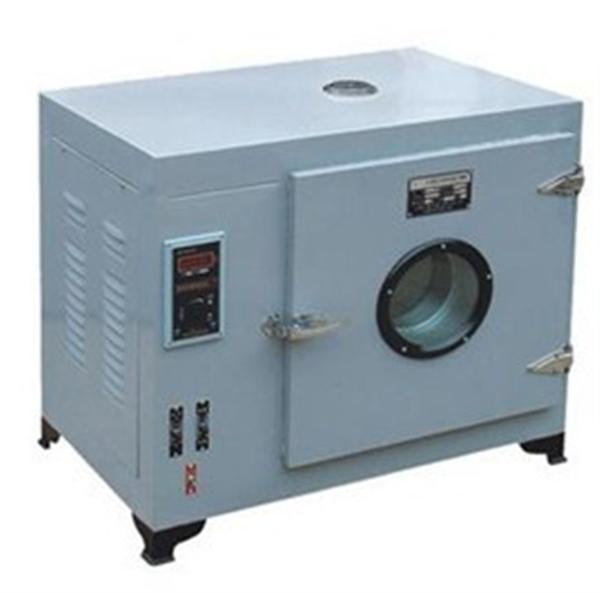Product Name: 101A Electric Blast Drying Oven
Overview
The maximum working temperature of the 101A Electric Blast Drying Oven is 300°C, equipped with a digital display temperature controller for precise and easy temperature control. The design ensures a clear interface and efficient heating performance, making it ideal for use in papermaking, packaging, medical fields, educational institutions, workshops, and laboratories.
The outer casing is made of thin steel plate with a lacquered surface, while the inner chamber is insulated with aluminum silicate fiber to provide excellent thermal protection. The heating elements are located at the bottom of the oven, and the power is controlled through an internal system to ensure safe and stable operation.
This model features a blast function, which enhances air circulation and improves drying efficiency, especially for materials that require even heat distribution.
How to Use
1. Place the oven indoors on a flat and stable surface.
2. Ensure the power supply is connected via a dedicated switch and has a proper grounding system.
3. Before turning on the device, double-check the voltage and wiring connections to avoid electrical issues.
4. For new or long-unused ovens, pre-bake at a low temperature (80–100°C) for about two hours before increasing the temperature. This helps remove moisture, improve insulation, and extend the lifespan of the porcelain components.
5. Insert the temperature probe into the designated measuring hole on the left side of the oven. Avoid inserting it from the top center hole to prevent interference with the temperature control system.
6. During the first use, monitor the oven closely to avoid overheating, which could damage the items being dried.
7. If the heat seems too intense, you can turn off one set of heaters to reduce the overall heating power and prevent excessive temperature rise due to thermal inertia.
8. When removing items from the oven, be careful not to touch or move the temperature control panel, as this may cause damage to the unit.
9. In case of any malfunction, consult a qualified electrician for assistance and avoid attempting repairs yourself.

Non-Shielded Control Cable YY CVV LIYY
Low Voltage Control Cables
When setting up an electrical system, choosing the right Control Cable is key for guaranteeing steady and reliable signal communication. In the realm of non-shielded options, three types rise to prominence for their specific benefits: Yy, Cvv, and Liyy.
Here's a thorough walkthrough to help you select the right non-shielded control cable for your operations.
Understanding Non-Shielded Control Cable Yy for Stable ConditionsThe "Non-Shielded Control Cable Yy," also referred to as YSLY or HSLH, is a staple in the industry due to its adaptability. It comprises finely stranded copper conductors coated in PVC, while its PVC outer layer offers basic defense against common environmental factors. It's well-suited for dry conditions where the demand for mechanical durability is low. Some applications for Non-Shielded Control Cable Yy include building automation, signal relay in industrial control systems, and home appliance wiring.
Non-Shielded Control Cable Cvv: Tailored for Dynamic InstallationsThe "Non-Shielded Control Cable Cvv" variant, known as well as YSLYV or HSLVY, steps up in terms of flexibility, thanks to an additional layer of tinned copper braid. This not only heightens mechanical protection but also aids in managing cable placement within dynamic settings. The Cvv cable is a choice selection for installations requiring regular movement, as found in machinery connections and temporary control units in environments that remain dry and undisturbed by harsh outdoor elements.
Non-Shielded Control Cable Liyy: Combining Flexibility with EMI DefenseFor locations experiencing moderate electromagnetic interference, the "Non-Shielded Control Cable Liyy," identifiable as YSLYCHY or HFLHCH, is designed to withstand such challenges. With an added braided shield of tinned copper, it goes beyond the Yy and Cvv's offerings by safeguarding signal integrity amidst EMI. Despite the additional protection, Non-Shielded Control Cable Liyy maintains considerable flexibility and is ideal for a variety of applications, including industrial plants where EMI is present and in building facilities where mild electrical noise is a factor.
Conclusive Thoughts on Choosing Your Non-Shielded Control CableThe decision on which non-shielded control cable - Yy, Cvv, or Liyy - to use, should be informed by:
The environmental conditions: moisture, stress, and EMI presence.
The degree of cable flexibility required during installation and use.
The specific role the cable will fulfill in the control system.
Adherence to safety and operational standards set within the industry.
With a clear comprehension of Non-Shielded Control Cable Yy, Cvv, and Liyy characteristics, your choice will be sound, ensuring a robust and reliable infrastructure for your electrical controls.
Standard applied: IEC60227, BS 6500
Rated Voltage: 300/500V 450/750V 0.6/1kV
Others: Fire Cable and other property Low Voltage Power Cable can be available
Applications: Those Control Cables are suitable for fixed installations as connection and inter-connection cables in general machine,production lines.
Non-Shielded Control Cable Yy Cvv Liyy,Non-Shielded Control Cable Yy,Non-Shielded Control Cable Cvv,Non-Shielded Control Cable Liyy
Shenzhen Bendakang Cables Holding Co., Ltd , https://www.bdkcables.com